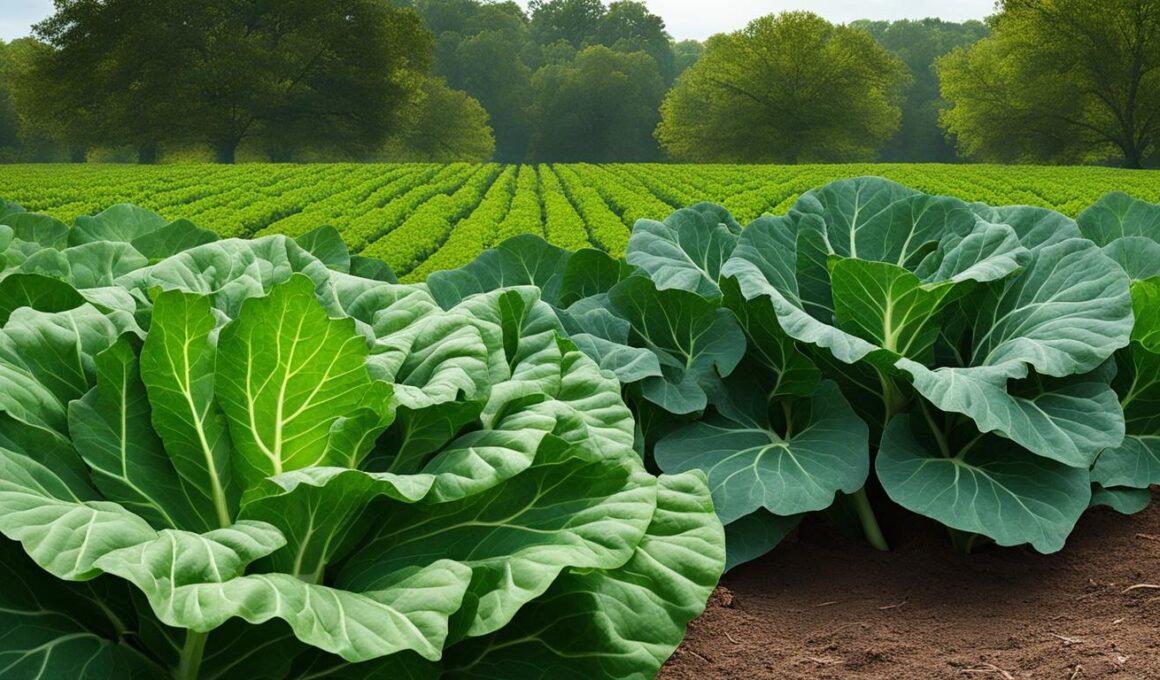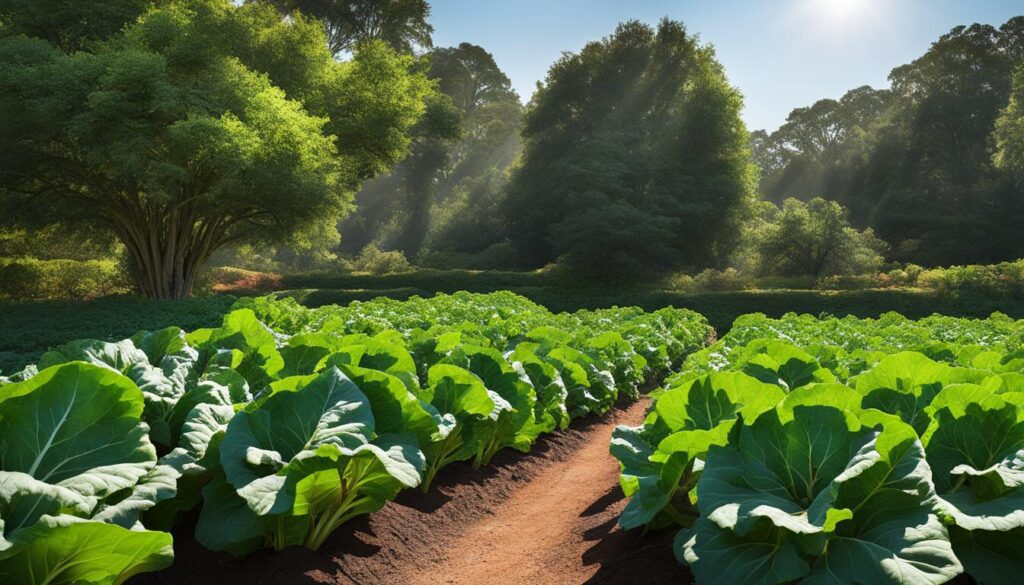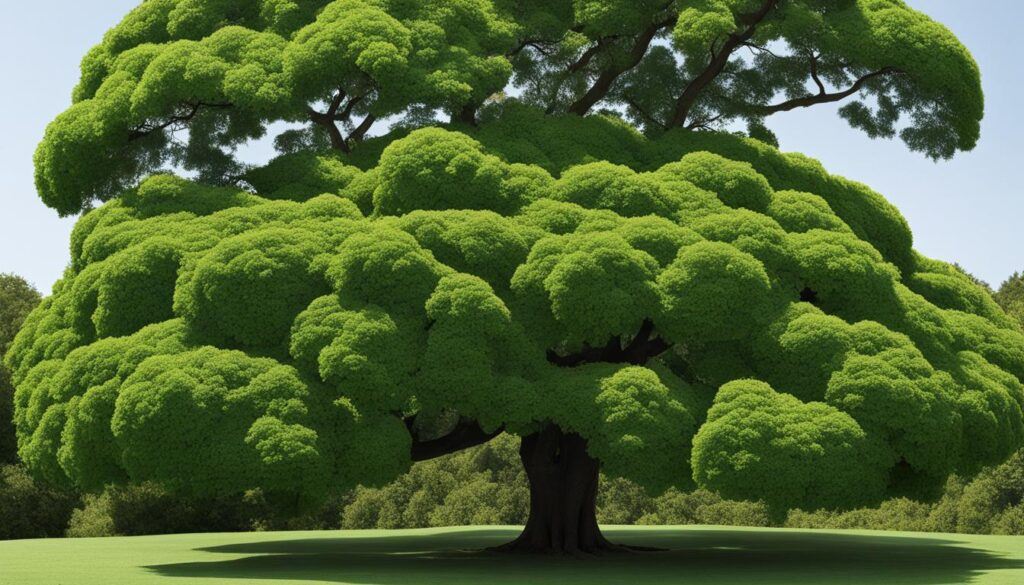If you’re a fan of leafy greens, you may have come across two popular varieties: tree collards and collard greens. While they both belong to the same species, Brassica oleracea, there are some notable differences between the two. In this article, we’ll explore the distinctions, benefits, and health aspects of tree collards and collard greens.
Key Takeaways:
- Tree collards and collard greens are cultivars of Brassica oleracea.
- Collard greens are biennials grown as annuals, while tree collards are perennials.
- Collard greens grow up to 2 feet, while tree collards can reach heights of up to 20 feet.
- Collard greens are more bitter in taste compared to the less bitter taste of tree collards.
- Both vegetables are rich in dietary fiber, vitamins, and minerals, making them beneficial for health.
Growing Tree Collards: Tips and Techniques
When it comes to growing tree collards, you’ll be pleased to know that they are relatively easy to cultivate, making them suitable for both beginner and experienced gardeners. Whether you have a small backyard or a large vegetable garden, tree collards can thrive and provide you with a bountiful harvest. Here are some essential tips and techniques to help you grow healthy tree collard plants:
- Choose the right location: Tree collards prefer partial to full sun, but if you live in a hot climate, they may benefit from some shade during the hottest part of the day. Make sure to select a spot in your garden that gets at least 6 hours of sunlight daily.
- Prepare the soil: Tree collards thrive in well-drained soil with a pH of 6.5. Prepare the soil by incorporating organic matter, such as compost or vermicompost, to improve fertility and drainage.
- Planting and spacing: You can propagate tree collards using rooted plants, cuttings, or seeds. Plant them at least 2 feet apart to allow enough space for the plants to grow and spread.
- Watering and maintenance: Tree collards require moderate water and do well in low-water conditions. Water the plants regularly, keeping the soil evenly moist but not waterlogged. Pruning may be necessary to maintain the plants’ height and remove any dead or damaged leaves.
- Companion planting: Tree collards have many companion plants, including herbs like basil and mint, vegetables like tomatoes and peppers, and flowers like marigolds. These companion plants can help attract beneficial insects and provide natural pest control.
With these tips and techniques in mind, you’ll be well on your way to growing thriving tree collards in your garden. From choosing the right location to companion planting, you can create an environment that supports the growth and productivity of your tree collard plants. So roll up your sleeves, get your gardening tools ready, and enjoy the process of growing your own nutritious tree collards.
Comparing Tree Collards and Collard Greens in the Kitchen
When it comes to cooking, both tree collards and collard greens offer a variety of culinary possibilities. Whether you’re looking to add some nutritious greens to your meals or exploring new flavors, these vegetables can be versatile additions to your kitchen.
Collard greens have a distinct bitter taste, similar to kale, which adds a robust flavor to dishes. On the other hand, tree collards have a milder taste compared to their counterpart, making them a great option for those who prefer a less bitter flavor profile. Both vegetables have edible leaves and are low in calories, making them a healthy choice for your meals.
Both tree collards and collard greens can be cooked in various ways, including steaming, boiling, or sautéing. They can be used in soups, stews, stir-fries, salads, or as wraps for delicious and nutritious meals. Their versatility allows you to get creative in the kitchen and experiment with different recipes.
Here are some ideas on how you can incorporate tree collards and collard greens into your cooking:
- Make a classic Southern-style dish by sautéing collard greens with onions, garlic, and a touch of vinegar or lemon juice.
- Add chopped tree collards or collard greens to your favorite soup or stew recipe for an extra boost of vitamins and fiber.
- Create healthy and flavorful wraps by blanching tree collard or collard green leaves and filling them with your choice of protein, veggies, and sauces.
- Explore international cuisines by adding tree collards or collard greens to dishes like stir-fried noodles, curries, or Mediterranean-inspired salads.
With their nutritional value, unique flavors, and culinary versatility, both tree collards and collard greens can elevate your meals and contribute to a well-rounded and healthy diet.
The Unique Features of Tree Collards
Tree collards, also known as walking stick cabbage or tree kale, possess several unique features that distinguish them from other cultivars of Brassica oleracea. These fascinating plants can grow to impressive heights, ranging from 8 to 10 feet, and in some cases even up to 20 feet, resembling actual trees rather than typical leafy greens. Their towering nature adds a striking visual appeal to any garden or landscape.
One of the most noticeable characteristics of tree collards is their vibrant leaves. They come in shades of blue, green, and purple, creating a beautiful contrast against their thick and sturdy stems. Their elongated leaves can reach up to 10 inches in length, making them quite the eye-catching feature in the garden.
In addition to their aesthetic appeal, tree collards are known for their nutritional value. They are an old American heirloom that is valued for its high protein content and health benefits. Like other members of the Brassica oleracea family, tree collards are packed with dietary fiber, vitamins, and minerals, making them a nutritious addition to any diet.
To successfully grow tree collards and showcase their unique features, it’s important to provide them with proper support and stability. Despite their tree-like appearance, these plants need to be staked to ensure they remain upright and secure. This ensures that they can continue to thrive and display their impressive height and foliage.
What are the nutritional differences between Tree Collards and regular Collard Greens?
Tree collards have thicker leaves and a slightly milder taste compared to regular collard greens. They are packed with nutrients like vitamin A, C, and K, which are essential for preventing tomato leaf burn. Regular collard greens have a similar nutritional profile but may have less of a tendency to prevent tomato leaf burn.
Conclusion
In conclusion, when comparing tree collards and collard greens, it’s clear that they are two distinct cultivars of the Brassica oleracea species. While both vegetables offer numerous benefits and can be used in cooking, they have notable differences.
Tree collards are perennials with remarkable height and unique visual appeal, resembling trees rather than typical leafy greens. On the other hand, collard greens are biennials grown as annuals, reaching a maximum height of around 2 feet.
Another significant difference is the taste. Collard greens have a more bitter flavor, similar to kale, while tree collards are less bitter, making them more appealing to those who prefer milder tastes.
Both tree collards and collard greens are highly nutritious, containing ample amounts of dietary fiber, vitamins, and minerals. They are excellent additions to a healthy diet and can be used in a variety of delicious dishes.
Whether you choose to grow tree collards or collard greens, both vegetables bring unique attributes and benefits to your garden and menu.
FAQ
What is the difference between tree collards and collard greens?
Tree collards are perennials that can continuously produce leaves for three to five years, while collard greens are biennials grown as annuals. Tree collards are also much taller, reaching heights of up to 20 feet, whereas collard greens grow up to 2 feet. Additionally, tree collards often have purple-colored leaves on their stems, while collard greens do not.
Are tree collards and collard greens nutritionally similar?
Yes, both tree collards and collard greens are rich in dietary fiber, vitamins, and minerals. They are both nutritious additions to a healthy diet.
How do I grow tree collards?
Tree collards are easy to grow and maintain. They can withstand cold temperatures and thrive in USDA zones 7-10. They can be grown alongside other crops and have many companion plants. Tree collards can be propagated through rooted plants, cuttings, or seeds. They require well-drained soil with a pH of 6.5 and partial to full sun. They also need moderate water and may require pruning and staking for height and stability.
How do tree collards and collard greens taste?
Collard greens have a more bitter taste, similar to kale, while tree collards are described as less bitter. Both can be cooked by steaming or boiling and used in various dishes or as wraps.
What are the unique features of tree collards?
Tree collards can grow to impressive heights, resembling trees rather than typical leafy greens. They have blue, green, and purple leaves, which can grow up to 10 inches long. Despite their tree-like appearance, they need to be staked for stability. Tree collards are known for their high protein content and nutritional value and can be an interesting addition to both edible and ornamental gardens.











